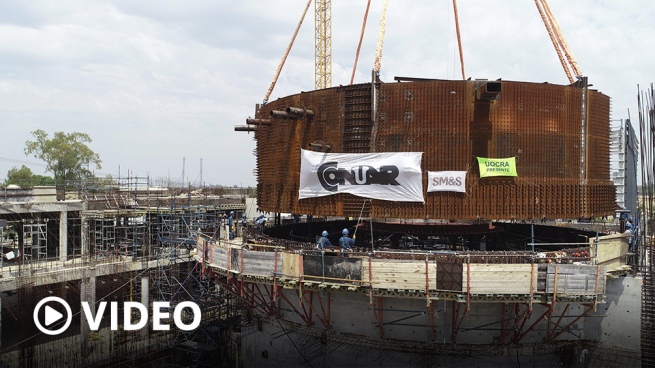The President of the National Atomic Energy Commission (CNEA), Adriana Serquis, highlighted that the Carem Projectthe domestic low power nuclear reactoris one of the three prototypes that are under construction in the world, and that will allow the country to offer a exportable solution for electricity generation with zero emissions, in the current energy transition process.
During a press conference at the Atucha Atomic Complex, where the construction of the 32Mw Carem project is under way, Serquis presented the advances of this reactor of national design and technology, for which the CNEA is working on the development of the supply chain. value with suppliers with the idea of achieving 70% local components.
The construction of the Carem nuclear reactor will provide an exportable solution for the energy transition
WATCH VIDEO
In parallel to the development of the prototype, the CNEA advances in the conceptual design of what will be the commercial module of Caremwhich will have a higher power (between 100 and 120 MWe), and would be the basis of a multi-reactor plant that will allow very competitive costs for the international market.
“We are in the construction stage of the 32Mw Carem, aspiring to be able to show all the advantages and possibilities of being able to build a small and modular power plant, in order to satisfy different needs that may arise both in Argentina and abroad with the idea of being able to have a project that can be exported in the future”, explained Sarquis.
Beside @Nucleoelectrica We receive the visit of national, provincial, municipal, union and business authorities so that they know the status of the Argentine Nuclear Plan, tour Atucha II and the work of the modular reactor #CAREM ⚛️ pic.twitter.com/HcuMAuGd2j
— National Atomic Energy Commission (@CNEA_Arg) April 12, 2022
The idea is that from this prototype it is possible to advance in the details to “improve and change its design and development, in order to understand other types of situations that allow it to offer possibilities from a technological point of view and have a Carem of 100 to 120 MW, which is an exportable product”.
The prototype is being built in Lima, Buenos Aires province. The building that will contain it covers an area of 18,500 square meters, of which around 14,000 square meters correspond to the so-called ‘nuclear module’, the sector that includes the containment of the reactor, the control room and all the security and control systems. center operation.
Civil works began on February 8, 2014, at which time Carem has become the first SMR (small modular reactor) in the world to be officially under construction.
“With this type of reactor we are at the first level of technology development, we are one of the first countries with the capacity to build this type of plant. Although there are more than 70 related projects, there are only three under construction and this is one of them “, highlighted the researcher, admitting that the “financial and political ups and downs” did not allow progress to be made at a better pace.
Serquis explained that “All over the world, modular reactor projects are thought of as the future, meeting the needs of climate change.”
“Nuclear energy is necessary to be able to move towards an energy matrix with zero emissions, and the solutions that these smaller intrinsically safe reactors can provide can provide a true solution in the shorter term than renewables as part of a set of technologies to an amelioration of climate change,” he added.
In this sense, the head of the CNEA highlighted “the level of development of the country in terms of technological contributions and components, with the development of the metal-mechanic industry and the work with potential bidders and local contractors, developing the capacity of SMEs to be able to be qualified from the nuclear point of view”.
But it also stands out in terms of “the possible applications of this class of reactors, which have great potential for supplying electricity to areas far from large urban centers or manufacturing and industrial hubs with high energy consumption, including the ability to feed seawater desalination plants.
In this way, small power scalable reactors in a modular way will allow power development to be offered at different levels and according to the scale that is needed in each place.
This first version of the Carem-type reactors capable of generating 32 megawatts of electricity stands out for a rigorous safety standard applied from the design, obtained through highly engineered solutions that simplify its construction, operation and maintenance.
It is expected that around 70% of its inputs, components and related services will be provided by Argentine companies certified under the demanding international quality standards, supervised by the CNEA.
The Carem site is part of the Atucha Atomic Complex where the Atucha I and Atucha II power plants are in operation, and on adjoining land, construction of Atucha III is expected to begin in early 2023, a US$ 8.3 billion project that will allow the country to master the technology of enriched uranium and light water.








